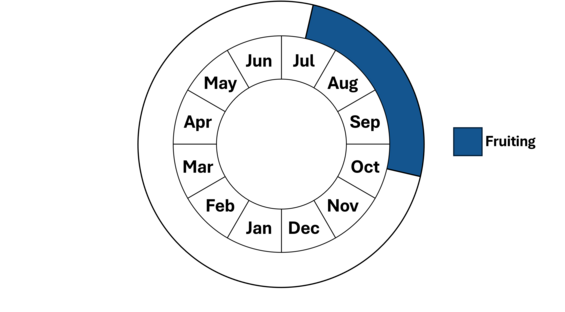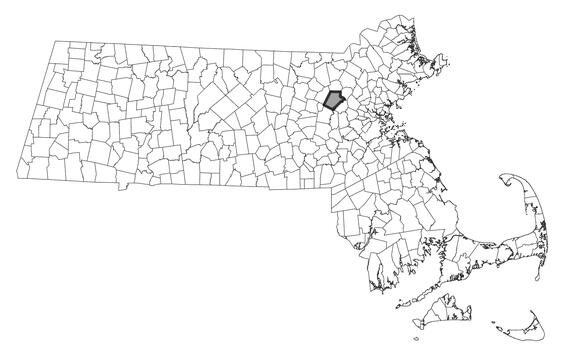- Scientific name: Isoete lacustris
- Species of Greatest Conservation Need (MA State Wildlife Action Plan)
- Endangered (MA Endangered Species Act)
Description
Lake quillwort is a perennial, aquatic, nonflowering member of the quillwort family (Isoetaceae). This inconspicuous species lives submerged in ponds as a rosette of linear leaves (somewhat resembling chives) and reproduces via spores. The rosette of lake quillwort is composed of sharply pointed leaves, 0.7 to 2 mm (0.03–0.08 in) wide and mostly 5 to 10 cm (2–4 in) long, occasionally reaching 20 cm (7.9 in). The leaves are dark green, firm, fleshy, and brittle, emerging from a very short, thick stem that is anchored in the substrate by a subterranean corm. The leaf bases of quillworts are swollen, flattened, and concave; the rosette is arranged tightly like the bracts of an artichoke. Within the swollen leaf bases are sporangia, sacs that house the male gametophyte-bearing microspores and the female megaspores. A sheath, or velum, covers the sporangia; in lake quillwort, the velum covers up to half of the sporangia. The megaspore of lake quillwort, which requires a microscope to view, is mostly covered with sharp, wavy crests, with a band (the girdle) encircling the spore that lacks ridges and is covered with tiny spines.
Quillwort species are very similar in appearance and identification requires examination of the ornamentation of mature megaspores under a microscope. Several pond quillworts occur in Massachusetts. Acadian quillwort (I. acadiensis), also listed as Endangered, has a smooth girdle and its ridges are smooth and rounded. The megaspores of Tuckerman’s quillwort (Isoetes tuckermanii) are similar in appearance to those of lake quillwort but smaller. The megaspores of both Tuckerman’s and acadian quillworts are 0.4–0.65 mm (0.02–0.03 in) in diameter, averaging less than 0.6 mm (0.02 in), whereas those of lake quillwort are 0.55–0.75 mm (0.02–0.03 in), averaging more than 0.6 mm (0.02 in). The megaspores of the remaining three species do not have girdles. Spiny-spored quillwort (I. echinata) megaspores are covered in spiny bumps; those of Engelmann’s quillwort (I. engelmannii) have a reticulate surface of regularly spaced ridges; and those of riverbank quillwort (I. riparia) are covered with crowded bumps and rough crests.
Life cycle and behavior

This is an aquatic, perennial species.
Population status
Lake quillwort is listed under the Massachusetts Endangered Species Act as endangered. All listed species are protected from killing, collecting, possessing, or sale, and from activities that would destroy habitat and thus directly or indirectly cause mortality or disrupt critical behaviors. The Massachusetts Natural Heritage & Endangered Species Program has 3 records from 3 counties: Hampden, Middlesex, and Worcester. One of these records has been observed within the last 25 years.

Distribution in Massachusetts
1999-2024
Based on records in the Natural Heritage Database
Distribution and abundance
Lake quillwort occurs from the Northwest Territories, Saskatchewan, and Minnesota east to Newfoundland and New Jersey. Disjunct populations are found in the mountains of Tennessee and Virginia. This species also occurs in Greenland and Europe.
Habitat
Lake quillwort occurs in cold, clear water of lakes, ponds, and slow-moving streams. It is typically submerged one to three meters and sometimes occurs in deeper water. At the single location in Massachusetts where it has recently been observed, it occurs at a depth of over 7 m (23 ft). Uprooted plants can sometimes be found along pond shorelines.
Healthy habitats are vital for supporting native wildlife and plants. Explore habitats and learn about conservation and restoration in Massachusetts.
Threats
Altered water levels, wells, septic systems, water recreation, and invasive exotic plants are all potential threats.
Conservation
Protection of the natural hydrological conditions, water quality, and substrate conditions in ponds supporting lake quillwort is needed to maintain extant populations. Lake quillwort populations should be monitored regularly, with surveys conducted when megaspores are mature, from late July to October. All active management of rare plant populations (including invasive species removal) is subject to review under the Massachusetts Endangered Species Act and should be planned in close consultation with MassWildlife’s Natural Heritage & Endangered Species Program.
References
Gleason, H.A., and A. Cronquist. 1991. Manual of Vascular Plants of Northeastern United States and Adjacent Canada, 2nd edition. The New York Botanical Garden, Bronx, NY.
Haines, A. 2011. Flora Novae Angliae – a Manual for the Identification of Native and Naturalized Higher Vascular Plants of New England. New England Wildflower Society, Yale Univ. Press, New Haven, CT.
Contact
| Date published: | April 25, 2025 |
|---|